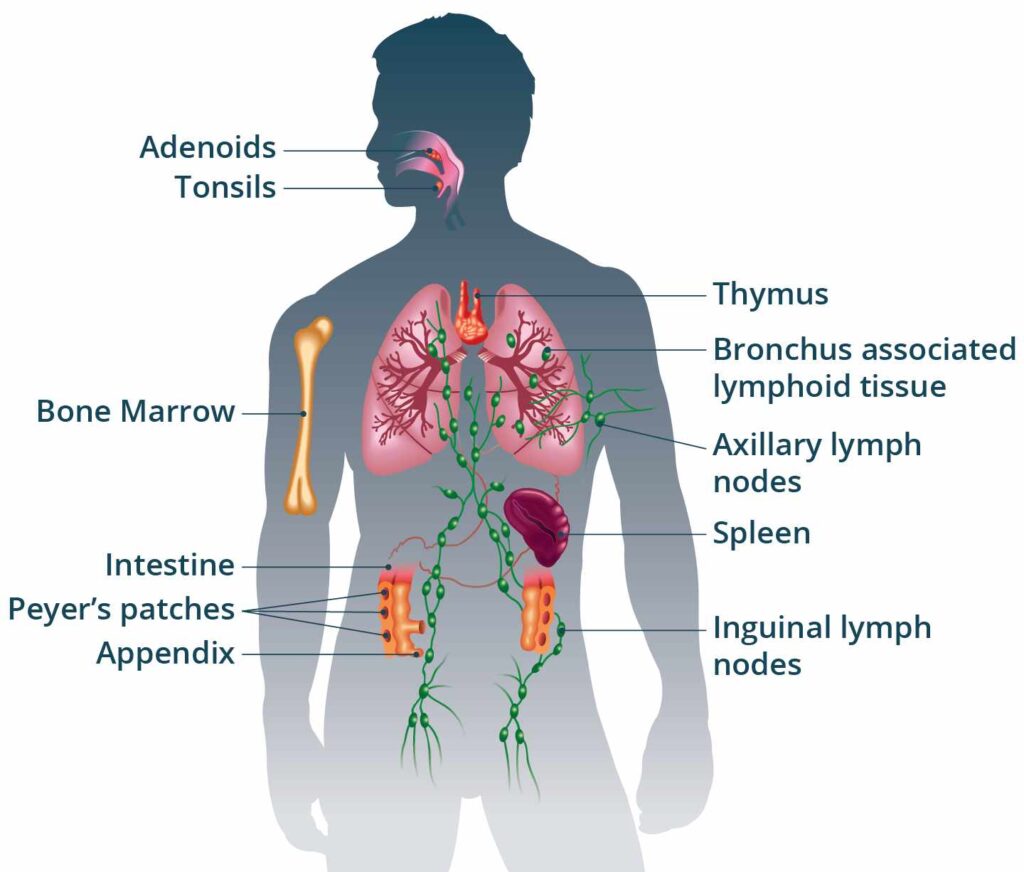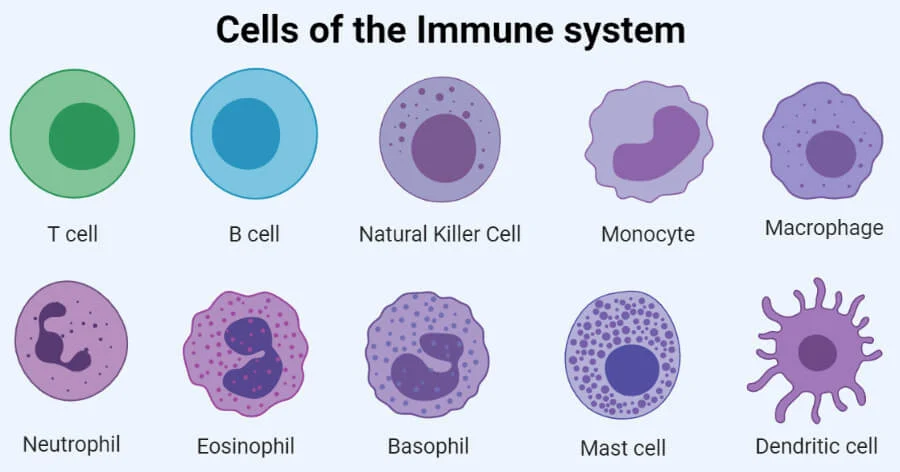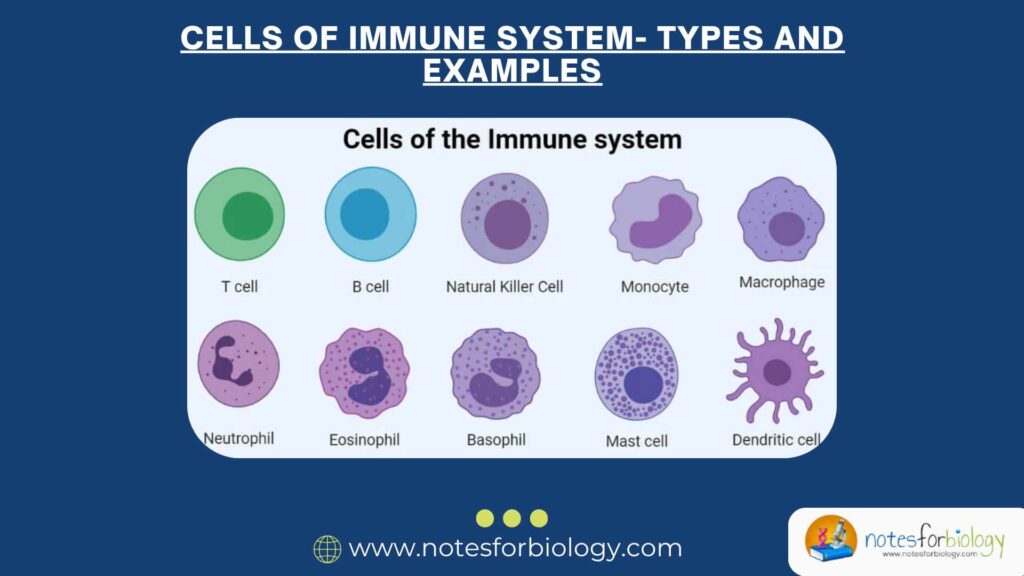Definition of Immune System Cells
The immune system consists of specialized cells that protect the body from infections, diseases, and foreign invaders. These cells can be divided into innate (fast, non-specific) and adaptive (slow, specific with memory) immunity.

Imagine your body as a fortress under constant siege by invisible enemies bacteria, viruses, parasites, and even rogue cancer cells. Standing between you and these threats is an elite, highly trained defense force: your immune system. This remarkable network of specialized cells works around the clock with military precision to keep you safe and healthy.
Summary of Immune System
Sure! Here’s the compressed version in a separated format:
- The immune system protects the body from harmful invaders like bacteria, viruses, and parasites using special immune cells.
- It is divided into innate immunity (quick, non-specific response) and adaptive immunity (slow, specific, with memory).
- Key immune cells include phagocytes, granulocytes, natural killer (NK) cells, T cells, and B cells, each with a unique role in defense.
Table of Contents

The First Responders: Innate Immunity’s Rapid Strike Team
Like a well-trained SWAT team, your innate immune cells spring into action the moment trouble is detected.
Macrophages are the special forces these mighty cells patrol your tissues, engulfing invaders whole while sounding the alarm to rally other defenses.
Neutrophils are the suicide bombers they storm infected areas, release deadly chemicals to destroy pathogens, and heroically sacrifice themselves in the process.
Natural Killer (NK) Cells are the stealth assassins they silently identify and eliminate virus-infected or cancerous cells with lethal precision.
These rapid responders don’t mess around. They attack first and ask questions later, buying crucial time for your body’s more sophisticated defenses to mobilize.
The Special Ops: Adaptive Immunity’s Intelligent Defense
While the innate immune system provides brute force, the adaptive immune system is like a team of brilliant spies and strategists.
T Cells are the master tacticians:
- Helper T Cells (CD4+) act as generals, directing the immune response and calling in reinforcements.
- Killer T Cells (CD8+) are the elite assassins, hunting down and destroying infected cells with deadly efficiency.
B Cells are the weapons manufacturers, producing antibodies – customized molecular missiles that lock onto specific invaders and mark them for destruction.
The best part is Some of these cells become memory cells, ensuring that if the same enemy attacks again, your body responds with overwhelming force. This is why vaccines work they train your immune system to remember threats before they even strike.
The Support Crew: Keeping the Defense Running Smoothly
No army operates alone, and your immune system has critical support units:
Platelets – Not just for clotting; they also help coordinate immune responses.
Dendritic Cells – The intelligence officers that gather intel on pathogens and present it to T cells.
Mast Cells & Basophils – The alarm triggers, releasing histamine to kickstart inflammation (even if it means making you sneeze).
Why This Matters for Your Health
A well-balanced immune system is the key to staying healthy. When it’s weak, you get sick more often. When it’s overactive, you develop allergies or autoimmune diseases. By understanding how these cells work, we can better appreciate:
- Why vaccines save lives (they train your immune memory)
- How cancer immunotherapy works (boosting T cells to fight tumors)
- Why antibiotics don’t work on viruses (they target bacteria, not your immune cells)
- How stress and sleep affect immunity (they weaken your defenses)
Conclusion
The immune system is like a highly organized army, with different cells working together to protect your body from harmful invaders like bacteria, viruses, and even cancer. Each type of immune cell has a unique role, ensuring that threats are detected, attacked, and remembered for future protection.
The innate immune system acts as the first line of defense, responding quickly but in a general way. Cells like macrophages, neutrophils, and NK cells attack anything foreign, while mast cells and eosinophils trigger inflammation and fight parasites. These cells don’t have memory, but they buy time for the more specialized adaptive immune system to kick in.
The adaptive immune system is smarter and more precise. T cells act as commanders (helper T cells) and assassins (killer T cells), while B cells produce antibodies that lock onto specific germs. Some of these cells become memory cells, ensuring that if the same germ attacks again, your body reacts faster and stronger—this is why vaccines work!
When everything functions correctly, your immune system keeps you healthy without you even noticing. But if any part fails—whether it’s weak neutrophils leading to infections, faulty NK cells increasing cancer risk, or overactive immune responses causing allergies—your health can suffer.
Understanding these cells helps us appreciate how our bodies fight disease and why treatments like antibiotics, vaccines, and immunotherapy work. It also explains why a balanced lifestyle good nutrition, sleep, and stress management—is crucial for keeping your immune army strong.
In short, your immune system is a brilliant, self-protecting network that works 24/7 to keep you safe. By learning how it functions, we can better support it and stay healthier in the long run.
Frequently Asked Questions (FAQs)
What are the main functions of the immune system?
The immune system protects the body from harmful invaders like bacteria, viruses, and parasites. It identifies and eliminates these threats to keep us healthy.
How does the immune system protect the body from diseases?
It detects harmful organisms and responds by attacking and destroying them. This prevents infections and helps the body recover from illnesses.
What are the key components of the immune system?
The immune system includes white blood cells, antibodies, the lymphatic system, spleen, thymus, and bone marrow. These parts work together to defend the body.
Related Articles




